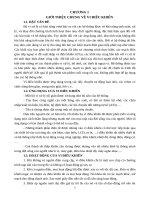2-7. Commonly Used Objects in jQuery
Bạn đang xem bản rút gọn của tài liệu. Xem và tải ngay bản đầy đủ của tài liệu tại đây (17.05 MB, 621 trang )
Chapter 2 ■ jQuery Fundamentals
Map Object
The map object contains key/value pairs. The syntax for declaring a map object is:
var variableName = { key1: value1, key1: value1, ... };
The key and value entries can be either primitive types or objects.
For example, to declare a map object, you’d use this code:
var employeeMap = {
"Name": "John Smith",
"Department": "Technology",
"Salary":50000,
"Joining Date": new Date("01/05/2010")
};
To display a key’s value in the map object, you’d use this code:
alert(employeeMap.Name);
To display all the key/value pairs in the map object, you’d use this code:
for (var k in employeeMap){
alert("Key: " + k + " Value:" + employeeMap[k]);
}
HTML Element
In this book, I use HTMLElement as a generic term for all the types of elements in the DOM tree—it can refer to
HTMLFormElement (for










